Serving 131 students in grades 6-12, Homewood School ranks in the top 30% of all schools in Maryland for overall test scores (math proficiency is top 20%, and reading proficiency is top 20%).
The percentage of students achieving proficiency in math is <50% (which is higher than the Maryland state average of 25%). The percentage of students achieving proficiency in reading/language arts is <50% (which is higher than the Maryland state average of 45%).
The student:teacher ratio of 3:1 is lower than the Maryland state level of 14:1.
Minority enrollment is 68% of the student body (majority Black), which is equal to the Maryland state average of 68% (majority Black).
Quick Stats (2025)
- School Type: Alternative school
- Grades: 6-12
- Enrollment: 131 students
- Student:Teacher Ratio: 3:1
- Minority Enrollment: 68%
- Graduation Rate: 70-79% (Btm 50% in MD)
- Overall Testing Rank: Top 30%
- Math Proficiency: <50% (Top 20%)
- Reading Proficiency: <50% (Top 50%)
- Science Proficiency: <50% (Top 20%)
- Source: National Center for Education Statistics (NCES), MD Dept. of Education
Top Rankings
Homewood School ranks among the top 20% of public schools in Maryland for:
Category
Attribute
Most improved public schools
Math Proficiency
Science Proficiency
Community Size
Student Attention
School Overview
Homewood School's student population of 131 students has stayed relatively flat over five school years.
The teacher population of 38 teachers has declined by 15% over five school years.
School Type
Grades Offered
Grades 6-12
(offers virtual instruction)
(offers virtual instruction)
Total Students
131 students
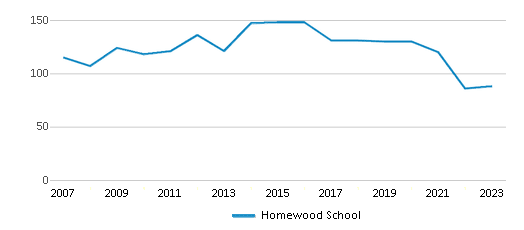
Gender %
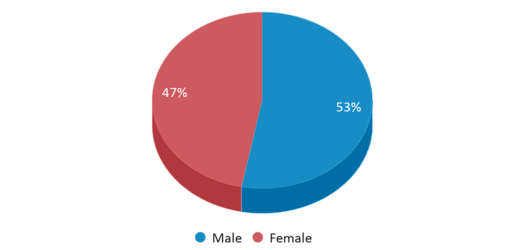
Total Classroom Teachers
38 teachers
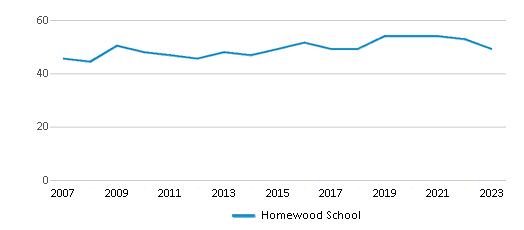
Students by Grade
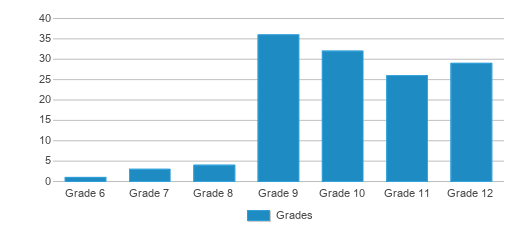
School Rankings
Homewood School ranks within the top 30% of all 1,347 schools in Maryland (based off of combined math and reading proficiency testing data).
The diversity score of Homewood School is 0.69, which is less than the diversity score at state average of 0.74. The school's diversity has stayed relatively flat over five school years.
Overall Testing Rank
#359 out of 1347 schools
(Top 30%)
(Top 30%)
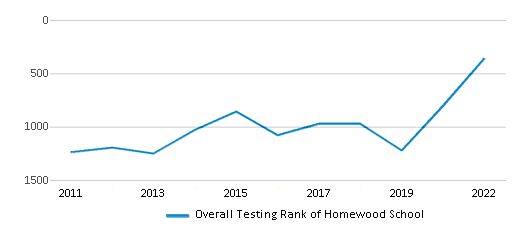
Math Test Scores (% Proficient)
<50%
25%
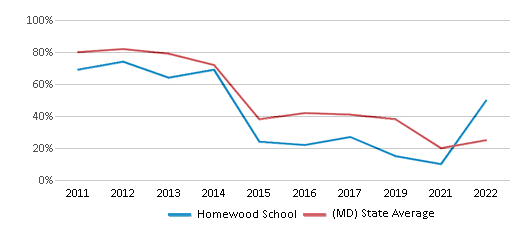
Reading/Language Arts Test Scores (% Proficient)
<50%
45%
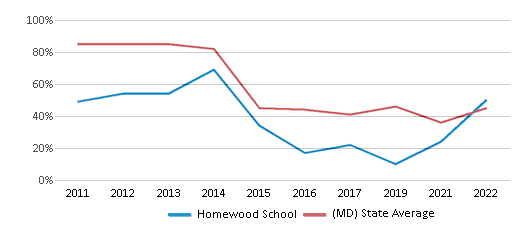
Science Test Scores (% Proficient)
<50%
36%
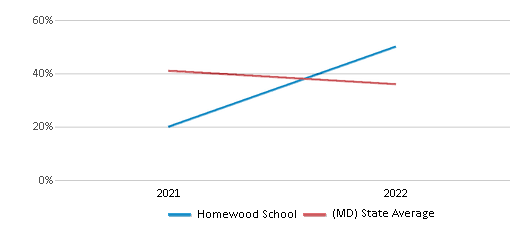
Student : Teacher Ratio
3:1
14:1
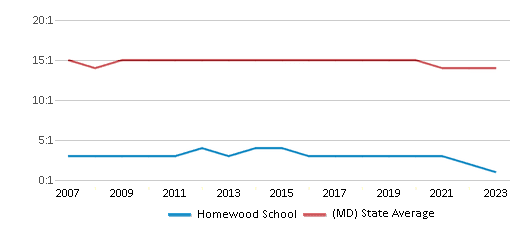
American Indian
n/a
n/a
Asian
4%
7%
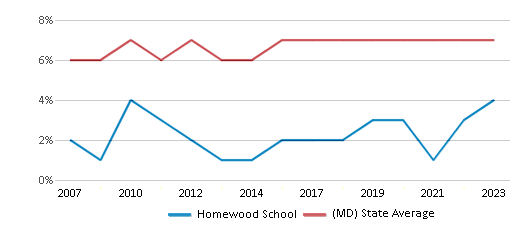
Hispanic
14%
23%
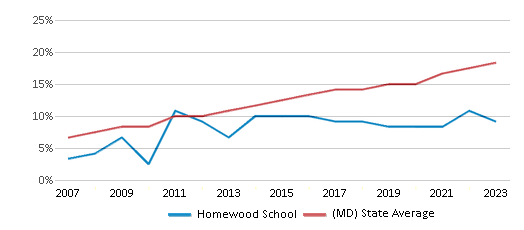
Black
43%
33%
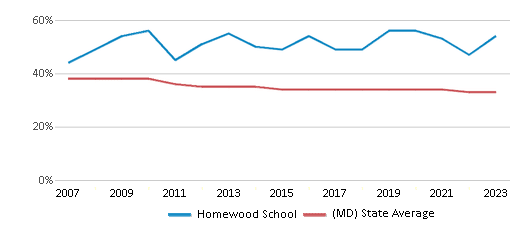
White
32%
32%
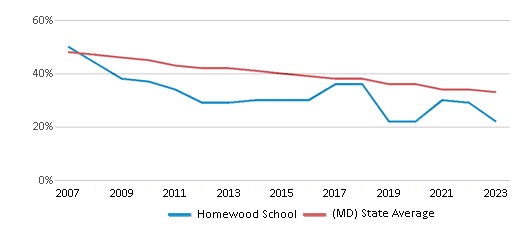
Hawaiian
n/a
n/a
Two or more races
7%
5%
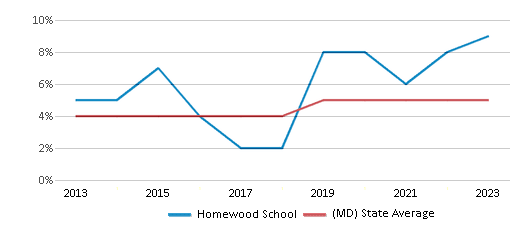
All Ethnic Groups
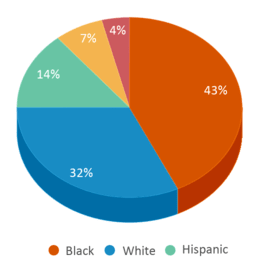
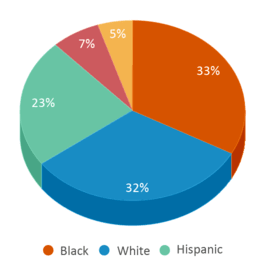

Graduation Rate
70-79%
86%
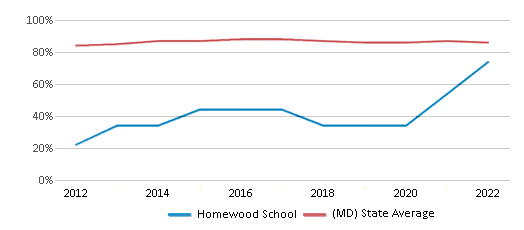
Participates in the National School Lunch Program (NSLP)
Yes
Eligible for Free Lunch
15%
44%
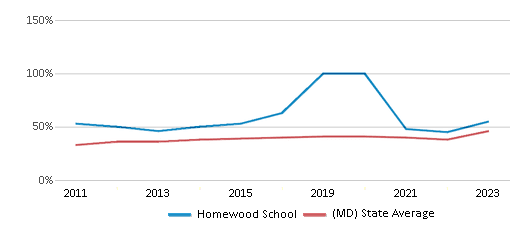
Eligible for Reduced Lunch
1%
5%
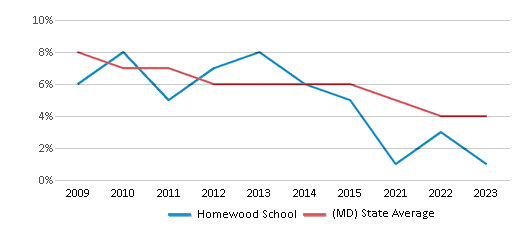
School Statewide Testing
School District Name
Source: National Center for Education Statistics (NCES), MD Dept. of Education
Profile last updated: 02/09/2025
Frequently Asked Questions
What is Homewood School's ranking?
Homewood School is ranked #359 out of 1,347 schools, which ranks it among the top 30% of public schools in Maryland.
What percent of students have achieved state testing proficiency in math and reading?
<50% of students have achieved math proficiency (compared to the 25% MD state average), while <50% of students have achieved reading proficiency (compared to the 45% MD state average).
What is the graduation rate of Homewood School?
The graduation rate of Homewood School is 70-79%, which is lower than the Maryland state average of 86%.
How many students attend Homewood School?
131 students attend Homewood School.
What is the racial composition of the student body?
43% of Homewood School students are Black, 32% of students are White, 14% of students are Hispanic, 7% of students are Two or more races, and 4% of students are Asian.
What is the student:teacher ratio of Homewood School?
Homewood School has a student ration of 3:1, which is lower than the Maryland state average of 14:1.
What grades does Homewood School offer ?
Homewood School offers enrollment in grades 6-12 (offers virtual instruction).
What school district is Homewood School part of?
Homewood School is part of Howard County School District.
School Reviews
1 9/20/2018
I attend the Bridges program not because I have behavioral problems, but because I have a rare pain disorder. The school is great for kids using it for its purpose, however my needs are very different and this environment does not meet them. The staff do not all acknowledge my medical condition and could do much more to accomadate me. They try to lump me together with all the other students creating the same goals for me. They care more about there schools mission then my health!
5 1/29/2015
Before my son started at Homewood, I only knew it as a place where they sent the "bad kids." What I know now is that this is a place where they will go to great lengths to help every child succeed. Don't expect them to sweat the small stuff, but do expect them to hold every child accountable for doing the best they can do. Every member of the staff is part of the support team for these kids, and they all do a great job. If your child has struggled in other HoCo schools, this could be a great place for them.
5 9/13/2013
This school is very friendly and helpful to all students and staff. They really focus on helping the students one on one no matter what the situation is. They want your child to succeed. Everyone is very, very caring. Especially in this world today
our kids need all the support and encouragement they can get. Thank you Homewood!
5 1/10/2011
My son has flourished since attending this school. He has had trouble all of his school career due to ADHD. The teachers are wonderful and really encourage the kids to blossom.
Review Homewood School. Reviews should be a few sentences in length. Please include any comments on:
- Quality of academic programs, teachers, and facilities
- Availability of music, art, sports and other extracurricular activities
Recent Articles

What Is A Charter School?
Explore the world of charter schools in this comprehensive guide. Learn about their history, how they operate, and the pros and cons of this educational innovation. Discover key facts about charter schools, including admission policies, demographics, and funding, as well as what to look for when considering a charter school for your child.

10 Reasons Why High School Sports Benefit Students
Discover the 10 compelling reasons why high school sports are beneficial for students. This comprehensive article explores how athletics enhance academic performance, foster personal growth, and develop crucial life skills. From improved fitness and time management to leadership development and community representation, learn why participating in high school sports can be a game-changer for students' overall success and well-being.

February 05, 2025
Understanding the U.S. Department of Education: Structure, Impact, and EvolutionWe explore how the Department of Education shapes American education, from its cabinet-level leadership to its impact on millions of students, written for general audiences seeking clarity on this vital institution.









